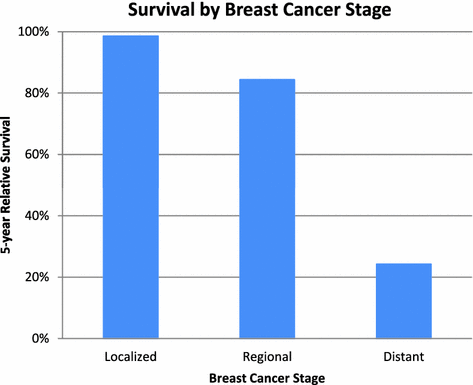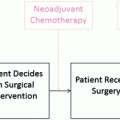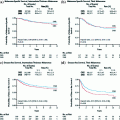Fig. 1
Impact of efficacy randomized controlled trials on the surgical management of breast cancer (select trials represented)
However, even as we acknowledge the important role of RCTs in defining the management of modern breast cancer, it is important to recognize their limitations. RCTs are conducted within a tightly controlled environment with strict inclusion and exclusion criteria. Practically speaking, this may result in the exclusion of patients with unfavorable baseline characteristics, such as significant comorbidities or advanced age. As an example, in National Surgical Adjuvant Breast and Bowel Project (NSABP)-B06, the clinical trial which defined our current surgical management of breast cancer, women over the age of 70 were excluded. Given that ~40 % of current breast cancer diagnoses occur in women over the age of 70, [4] exclusion criteria such as these have the potential to limit clinicians’ ability to apply trial findings to real-life patient populations. Similarly, RCTs require strict adherence to treatment protocols, and may include central auditing of pathology and imaging findings, surgical credentialing, and enhanced patient follow-up; however, many of these components may be altered or omitted as these treatments are implemented in clinical practice, potentially impacting outcomes observed. In contrast to the highly-controlled environment of efficacy trials, effectiveness research provides insight into treatment effects under ‘real-world’ conditions, which may differ substantially from the trial setting.
There are also a number of factors specific to surgery which make conducting RCTs challenging. In general, the field of surgery has traditionally depended less on RCTs to test new surgical interventions compared to other aspects of medicine, such as clinical drug trials. Consequently, many new surgical techniques (especially those that represent a less invasive or morbid approach) are disseminated into clinical practice prior to any RCT data supporting their efficacy or safety, making it challenging to then generate the supporting data. A pertinent example of this is the SLN biopsy for breast cancer. The SLN biopsy for breast cancer was first described in two small, single-institution studies [5, 6]. In 1999, a RCT began with the intent to validate the SLN biopsy concept [7]. Patients were randomized to SLN biopsy followed by either immediate axillary lymph node dissection (ALND) versus ALND only if the sentinel node was positive. Ultimately, this trial, reported in 2010, demonstrated equivalent overall and disease-free survival as well as regional control with a SLN biopsy [7]. However, in the intervening years between trial initiation and reporting of results, the practice of SLN biopsy became broadly incorporated into standard breast surgery practice, with 59 % of early stage breast cancer patients undergoing SLN biopsy rather than ALND by 2004 [8]. Although the NSABP-B32 trial definitively validates the SLN concept, its practical role was to support the standard of care clinical practice already in place rather than inform practice change.
Additionally, accomplishing randomization in surgical trials can be challenging, as both patients and surgeons dislike the idea of random allocation to a treatment arm. In the era of active patient participation in therapeutic decision-making, patients often resist randomization between surgical treatments, especially if one represents a less invasive therapeutic option. Addressing surgeon biases regarding treatment allocation is equally challenging, as surgeons have their own personal preferences regarding what may be the best treatment option for their patients and a particular familiarity with a given procedure as part of their skill set. Surgeons may be reluctant to recommend enrollment in a clinical trial when they view one of the trial arms more favorably or view the risks of randomization as unacceptably high. Several examples of patient and provider bias can be seen in the execution of prior RCTs in breast cancer. For example:
American College of Surgeons Oncology Group (ACOSOG) Z0011: This study examined whether ALND is necessary after positive SLN biopsy in women undergoing BCT for invasive breast cancer. Women with positive SLNs were randomized to completion axillary dissection versus observation, and overall survival and local recurrence was determined to be similar between the two groups [9, 10]. Target enrollment was 1,900 patients; however, the study closed early due to lower than expected accrual (<50 % of target) and event rates. This trial began accrual in 1999, at a time when the SLN concept was still being disseminated into wide-spread clinical practice [8]. The timing of trial initiation is likely one factor that influenced the slow accrual, as it may reflect surgeons’ reluctance to enroll patients on a trial that avoided an ALND for node positive patients when many were still performing an ALND for even clinically node negative patients. This concept of surgeon bias is further indirectly supported by the low volume axillary disease of patients enrolled in the trial (~40 % with micrometastases), supporting that surgeons selectively enrolled their very low risk patients in the trial [9, 10]. As a result of this clinical trial, women undergoing breast conservation with 1 or 2 positive SLN may be spared a completion ALND. However, the selective accrual of “low-risk” patients to this trial limits the patient populations these findings can be applied to.
Cancer and Leukemia Group B C9343: This study evaluated patients >70 years of age undergoing BCT to determine whether whole-breast radiation along with tamoxifen improved outcomes compared to tamoxifen alone [11]. Outcomes (recurrence, overall survival) were similar between the groups, and omitting radiation from the adjuvant treatment of women over the age of 70 is now a standard of care option for appropriate women. It is noteworthy that at initiation of the trial, eligibility criteria included T1 or T2 (tumors up to 4 cm) with no restrictions on estrogen receptor (ER) status. However, “in an attempt to broaden participation by physicians concerned about the upper size limit”, eligibility criteria was changed to limit tumor size to 2 cm and require ER status to be positive or unknown. Following this change, accrual was rapidly completed. Of note, at accrual completion, only 14 of 636 women had T2 tumors, and only ten were ER negative [11]. As a result of this clinical trial, women over the age of 70 may consider omitting radiation from their breast conservation treatment plan, although the applicability of this study’s findings is limited to a small subset of the older breast cancer patient population due to its strict inclusion criteria.
These examples highlight the challenges associated with randomization in surgical trials, as well as how surgeon bias can affect trial accrual and even lead to early trial closure. Ultimately, these issues will impact generalizability of the clinical trial to the real world setting.
3 Breast Cancer-Specific Limitations to Efficacy Trials
In addition to the general challenges associated with conducting RCTs, there are a number of unique characteristics associated with breast cancer which make some aspects of care difficult to assess with a RCT (Table 1). These largely reflect our success in treating breast cancer (with an associated improved survival) and the increasing role patients and their preferences play in treatment decision-making.
Table 1
Limitations of efficacy randomized controlled trials in breast cancer and possible solutions provided by comparative effectiveness research
Challenges to performing RCT in breast cancer | Use of CER to overcome challenges | |
|---|---|---|
Improved outcomes (survival, recurrence) | Large number of patients required to identify small differences in oncologic outcomes | Retrospective evaluation of large data sets (i.e. administrative data, etc.) |
Extended follow-up period to assess delayed outcomes | Meta-analysis to evaluate pooled data | |
Often prohibitively time and financially intensive, given favorable overall prognosis | Decision-modeling to evaluate theoretical outcomes associated with different options | |
Discrepancy between outcomes in clinical trial and real life | Pragmatic clinical trials to evaluate real life outcomes with incorporation of patient-centered outcomes | |
Improved outcomes may increase relative importance of other patient-centered outcomes (see below) as surrogate endpoints | ||
Patient preferences | Breast cancer management especially preference-sensitive | Retrospective evaluation of large data (avoids need for randomization but requires selection bias controls) |
Patients may resist randomization if not aligned with their values | Use of qualitative research to explore patient values | |
Some questions not amenable to randomization | Development of validated decision aids | |
Patient-centered outcomes | Few validated tools for objective measurement of outcomes | Expanded research to develop tools assessing outcomes valued by stakeholders |
Subjective and objective measures may not correlate | Qualitative research methods to explore stakeholder values |
Implications of Prolonged Survival: With improvements in cancer detection and treatment, the prognosis for breast cancer patients has markedly improved in the past 20 years. The 3-year survival for the 3 million breast cancer survivors currently living in the United States exceeds 97 % for localized (node negative) and 84 % for regional (node positive) disease (Fig. 2) [4]. The increased overall survival and decreased local recurrence associated with modern breast cancer treatment represents a challenge in conducting efficacy RCTs, as predicted differences between treatment groups will be small and require an extended period of follow-up to identify. Conducting such trials would therefore require large patient cohorts to have adequate power which will be prohibitively expensive and time-intensive, and may not yield a meaningful clinical outcome.
One option to address this challenge is to limit inclusion criteria for clinical trials to select “higher-risk” sub-groups for whom differences may be more easily observed. However, such inclusion criteria may increase the difficulty in patient accrual, and would not represent a feasible method for studying processes with high cure rates like DCIS.
Patient Preference: When compared to other cancers, decision-making surrounding breast cancer management is especially preference-sensitive (decisions regarding mastectomy versus breast conservation, reconstruction choices, etc.). These preferences may also determine how patients perceive and ultimately decide to participate in, a clinic trial. Investigators must therefore address this in their trial design to ensure adequate trial accrual. For example, NSABP-06 randomized women between one of the three treatment arms: mastectomy, segmental mastectomy followed by breast irradiation, or segmental mastectomy alone. These treatment arms represent therapies with relevant differences in patient-centered outcomes including quality of life and body image. In recognition of the challenges to randomly assigning women to one of these very different arms, investigators designed the trial using a “pre-randomization” technique. After assessing women for eligibility this study, patients were pre-assigned to one of the treatment groups. Patients were then approached for participation and disclosure of their pre-randomization arm was included in the consent process. Only patients who accepted their pre-assigned therapy and provided informed consent were enrolled in the trial. A total of 2,024 women were randomized to the three treatment arms. Despite these measures, the assigned treatment was still refused by 175 patients, with 78 refusing mastectomy, 55 refusing segmental mastectomy plus breast irradiation, and 41 refusing segmental mastectomy alone [12]. Overall, however, this “pre-randomization” design allowed patients to consider their personal preferences for treatment when deciding whether to participate in the trial and allowed successful completion of the trial, which defines our current standard of care for breast cancer surgery.
In addition to representing a challenge to trial accrual, patient preference limits to some degree what types of questions can be answered in efficacy trials, as randomization for many questions may be either unethical or not feasible. One pertinent example is examining outcomes of risk-reducing surgery for women at elevated risk of developing breast cancer (i.e. BRCA1 and BRCA2 mutation carriers). To date, there is no level 1 evidence supporting a survival benefit to risk-reducing surgery, and the necessary study is unlikely to ever occur given the ethics associated with randomizing high-risk women in such a preference–laden scenario. Other examples of clinical questions unlikely to be answered through efficacy RCTs include consideration of the role of contralateral mastectomy for women with a new cancer diagnosis and outcomes after different types of post-mastectomy reconstructive procedures.
Studying Patient–Centered Outcomes: With the improvement in recurrence and survival observed in breast cancer, increasing emphasis has been placed on alternative patient-centered outcomes such as range of motion, quality of life, sexual function, cosmesis, and patient satisfaction. These outcomes can be negatively impacted by the breast cancer treatment administered, and are highly valued by breast cancer survivors. Unfortunately, it can be challenging to measure these outcomes as appropriate and sensitive tools are not always available. Additionally, the relative importance of many of these outcomes may vary based on the individual patient, and objective and subjective measures of the same outcome may not correlate. For example, in a prospective study of lymphedema in women who underwent SLN biopsy or an ALND, significant differences were observed in the rates of patient-reported (subjective) and objectively measured lymphedema [13]. Further, many survivors with objectively measured changes in limb volume did not report having clinical symptoms of lymphedema. This example highlights some of the challenges associated with evaluating patient-centered outcomes and even defining what outcomes should be measured.
Further, understanding patient satisfaction in relation to surgical decision-making, reconstruction, and cosmesis is in its infancy. Although reconstruction plays a key role in patient satisfaction for their surgical breast cancer treatment, it has no effect on cancer recurrence or survival and is therefore rarely reported in RCTs. Assessment of cosmetic outcome is extremely challenging and difficult to quantify, although robustly validated measurement tools are becoming more readily available [14]. Patients’ assessment of their cosmetic outcome is heavily impacted by pre-operative expectations and their overall satisfaction with their cancer care, resulting in possible discordance between objective and subjective measures. Finally, there are notably wide regional, socio-economic, and demographic variations in rates of breast reconstruction after mastectomy that are poorly understood. Although these variations are likely multi-factorial, patient preferences and values play an important role in patient decision-making for reconstruction and the differences in priorities between different populations represent an additional challenge in assessing these and similar outcomes.
4 Breast Cancer Clinical Questions Amenable to Comparative Effectiveness Research
In day-to-day practice, physicians routinely encounter clinical questions about breast cancer care which have not been satisfactorily addressed with RCT data and are unlikely to be ever addressed in this manner. However, many of these questions may be appropriate to examine using CER methodologies. Summarized below are several key clinical questions in breast cancer which do not currently have RCT-based evidence available to guide decision-making. We will discuss why these particular questions are important to address as we strive to improve the quality of care we provide breast cancer patients, examine why they are not amenable to study using typical efficacy trials, and explore how these questions may be approached from a CER perspective.
Stay updated, free articles. Join our Telegram channel

Full access? Get Clinical Tree







